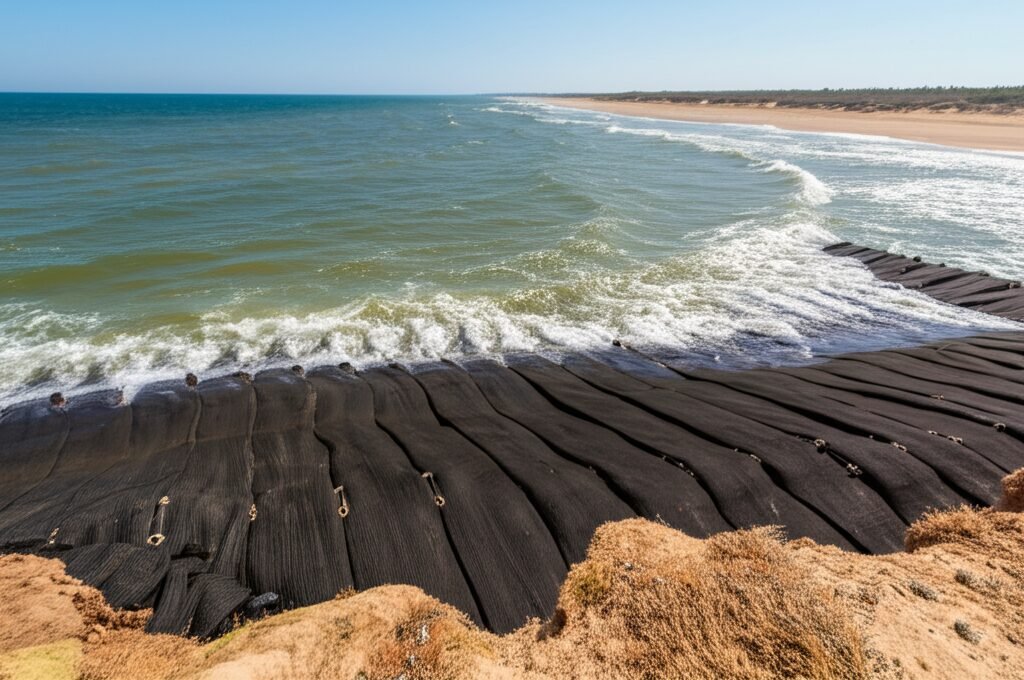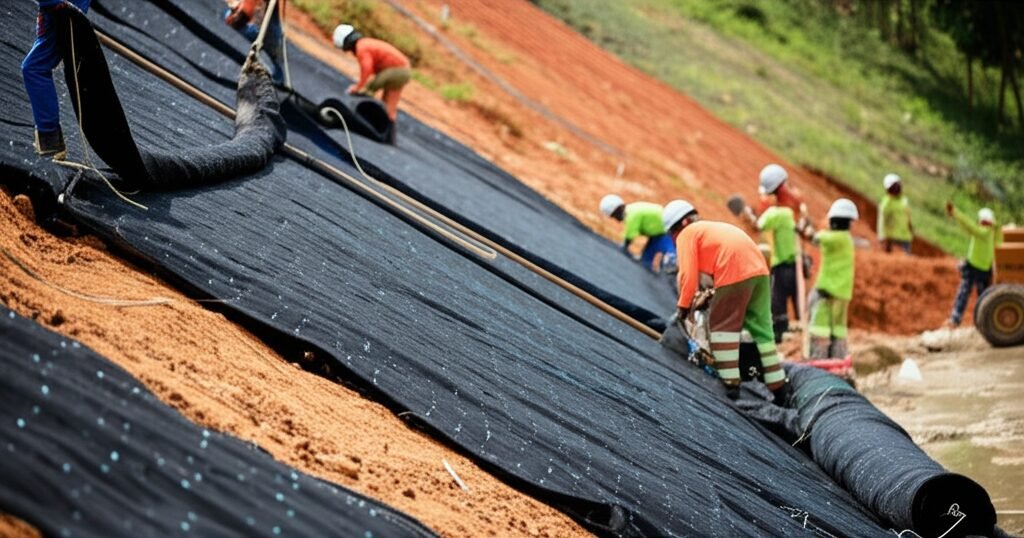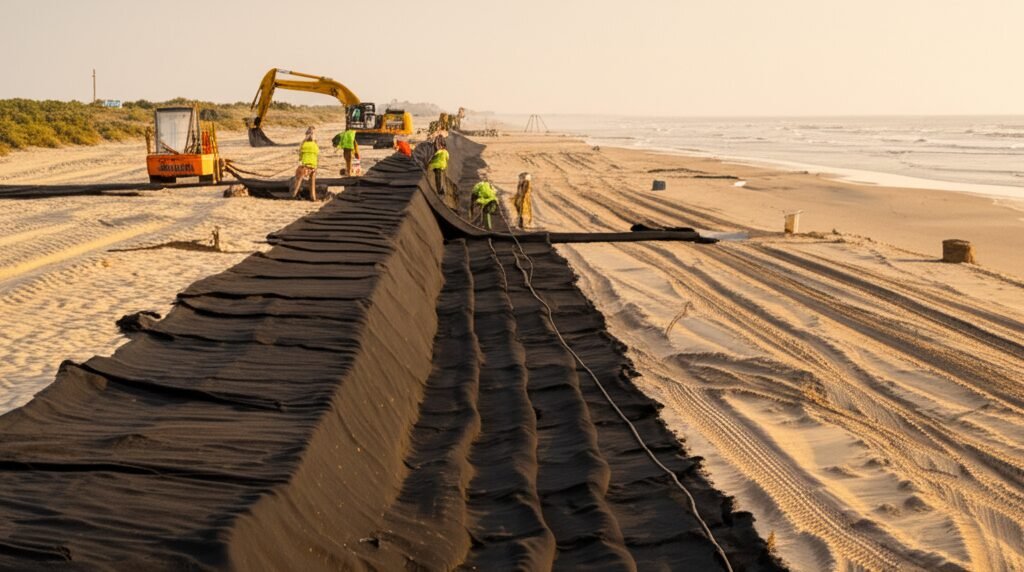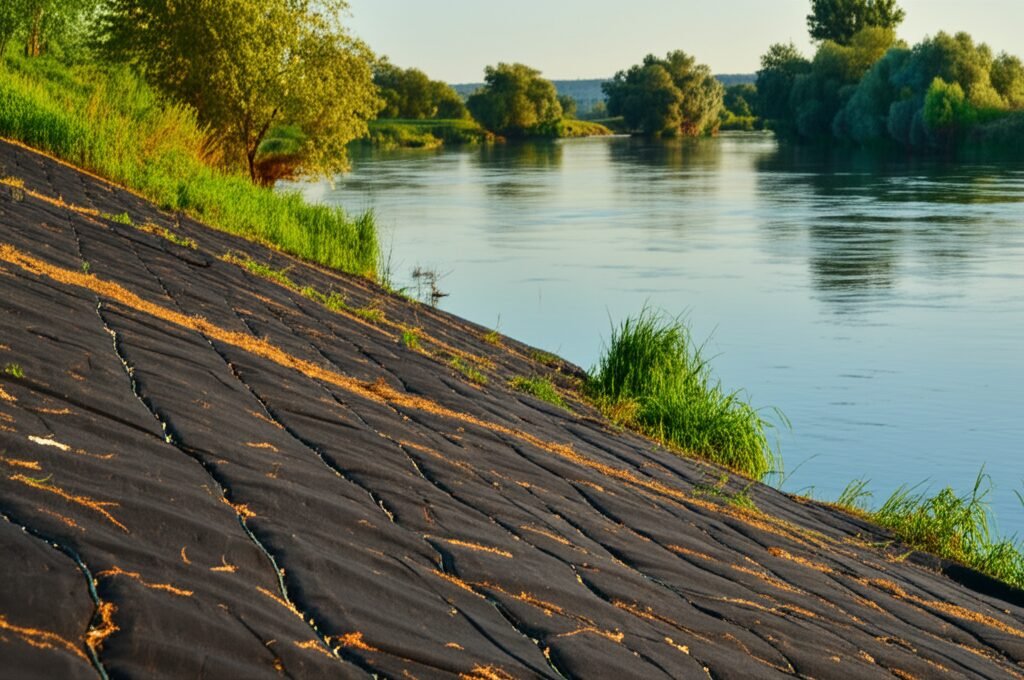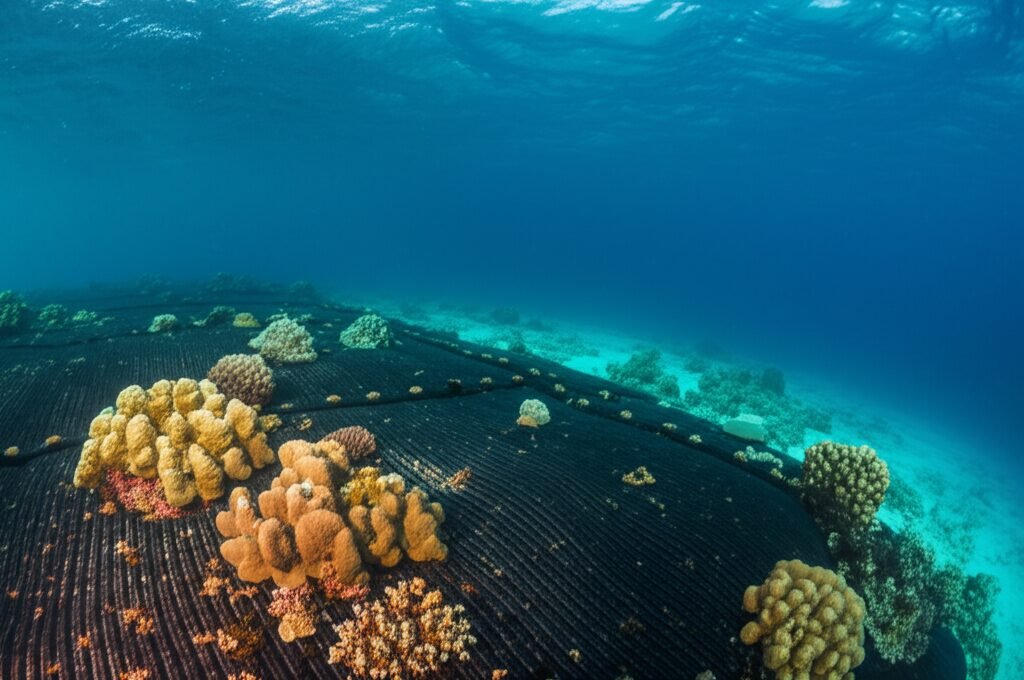Marine Construction Benefits and Shoreline Protection Methods
Benefits in Marine Construction and Coastal Erosion Control
Key Takeaways
- Erosion Stops: Geotextile mattresses create a strong, flexible barrier against waves and currents, holding sand and soil in place.
- Construction Helper: They provide stable bases for marine structures like seawalls and protect foundations from getting undermined (scour).
- Adapts Well: These systems conform to uneven seabeds and slopes, unlike rigid structures.
- Often Greener: Compared to solid concrete, they can have less impact and even support some plant life with special designs.
- Long-Lasting: Made from tough synthetic fabrics, they resist saltwater, sun, and biological growth pretty good.
- Versatile Use: Good for shorelines, riverbanks, bridge piers, underwater pipelines, and more. See Geotextile Mattress Uses, Construction, Benefits & Installation Guide.
Introduction: Why We Need Better Coastal Defense Now
Our coastlines, they’re always changing, right? But lately, it feels like things are speeding up. We hear lots about rising sea levels, maybe see bigger storms hitting the news more often. What that means on the ground, or rather, at the water’s edge, is erosion. Good ol’ solid land just getting washed away. It’s a massive headache for folks living near the coast, for ports, for roads, basicly anything built near the water. You cant just ignore it, hoping it’ll go away. It causes real damage, costs a fortune to fix after the fact, and sometimes, its just unsafe. For years, we built big concrete walls or dumped tons of rock (riprap, they call it). And sometimes that works, sure, but its expensive, can be ugly as sin, and doesn’t always fit the specific problem your facing. Sometimes, a big storm just rips those rocks right out.
So, people started looking for smarter ways, stuff that works with the environment a bit better, maybe lasts longer, or is easier to put in tricky spots. This is where engineered solutions like geotextile mattresses come into the picture. It sounds kinda technical maybe, but the idea is fairly simple: use strong fabrics to hold protective materials right where you need ’em. It’s about bein’ precise and efficient. We need robust solutions, no doubt about it, things that can handle the tough marine environment. Losing coast isn’t just losing land; it’s losing habitats, infrastructure, property value. Finding the right defense is critical, and that often means exploring options beyond the old standbys. Getting Expert Geotextile Mattress Solutions for Erosion Control involved early can save a lot of hassle later. They understand the nuances of different coastal situations, something you dont get from just reading a general manual. We’ve seen projects where the wrong approach was taken initially, and the cost to redo it was way higher than getting it right the first time.
Geotextile Mattresses in Marine Work: What Are They Actually?
Okay, so what is this “geotextile mattress” thing anyway? Don’t picture something you sleep on. Think more like a very specialized, super tough fabric container. It’s usually made from synthetic materials – polyesters, polypropylenes, stuff like that – woven or non-woven into large, flat “bags” or “envelopes”. The key thing is, they arrive on site often empty or flat-packed. Then, you fill ’em up. What you fill them with depends on the job, but in marine work, it’s common to use sand, gravel, or more often, a special concrete or grout mix. This mix is pumped in, filling the mattress and making it heavy and stable. Imagine a big, flat, heavy fabric-covered block, but one that was flexible before it was filled. That flexibility is important; it lets the mattress fit snugly against the seabed or a sloping bank, even if it’s uneven.
Now, for marine and coastal stuff, these aren’t just any old fabric bags. The materials gotta be tough. They need to resist saltwater corrosion, which eats away at lots of things. They need to handle sunlight (UV rays) without becoming brittle. And they need to discourage barnacles and algae from making a home on them, or at least not be damaged by it. There are different designs too. Some are built mainly for weight and stability. Othrs, like Advanced Filtration Geotextile Mattress Systems, have special fabric properties. These let water pass through slowly, relieving pressure from behind (like groundwater seeping out) but keep the soil particles trapped. This stops erosion from happening underneath the protection. Having folks like Li Gang: Expert Geotextile Mattress Manufacturing Leader involved in the production ensures the quality control is there. You need that consistency when you’re placing these things in critical spots, sometimes underwater where inspection is tricky. The fabric weave, the seam strength, the fill port design – it all matters. It’s not just a bag; it’s an engineered system designed for a harsh environment.
Holding the Line: How Geotextiles Stop Shoreline Erosion
So how does a fabric mattress, even one filled with concrete, actually stop the sea from chewing away at the shore? It works in a few ways, really. First, it acts like a shield, a protective layer over the vulnerable soil or sand. Waves crash, currents flow, but instead of hitting loose earth, they hit this heavy, stable mattress. The energy gets dissipated, spread out over the surface of the mattress instead of digging into one spot. Think about how a sandy beach gets carved up by waves – the mattress prevents that direct impact and scouring action. Because they’re kinda flexible before the fill sets (if using grout/concrete), they can be laid down to follow the exact shape of the shoreline or the seabed. This is a big plus compared to rigid concrete walls, which can leave gaps underneath if the ground isnt perfectly flat. Water can get into those gaps, scour out the material from behind, and eventually cause the whole wall to fail. Geotextile mattresses avoid this by having near-total contact.
Another key thing, especially with the filtration types, is preventing that sneaky erosion from underneath or behind. Water pressure can build up in the soil behind a structure, trying to push its way out. If it carries soil particles with it, you get internal erosion, weakening the whole defence. Filtration geotextiles let the water seep out nice and slow, relieving the pressure, but the fabric pores are too small for the soil bits to escape. It like a coffee filter, but for dirt and water. We worked on a project once, a small coastal community, where their old rock revetment just kept settlin’ and sinking. Waves were pulling the sand out right through the gaps in the rocks. We replaced a section with grout-filled mattresses, tailored to the slope. The difference was night and day. No more sinking, and the beach profile actually started to build up abit seaward of the mattresses. It showed just how effective containing that soil base is. Understanding the Advantages and Applications of Geotextile Mattresses in Erosion Control helps choose the right type for the right bit of coast. It isnt a one-size-fits-all game.
Building Better by the Sea: Marine Construction Advantages
Geotextile mattresses arent just for stopping erosion directly on the beach face; they’re real handy in marine construction projects too. Think about building anything heavy near or in the water – a breakwater, a jetty, maybe the foundation for an offshore wind turbine, or even just protecting a pipeline laid on the seabed. You often need a stable base, something that won’t shift around or get undermined by currents and waves washing away the sediment underneath. This undermining process is called scour, and it’s a major pain for marine engineers. Bridge piers in rivers or estuaries are classic examples where scour can be dangerous, potentially weakening the whole structure. Laying geotextile mattresses around the base of a pier, or under the foundations of a breakwater, creates an “apron” that prevents the water flow from digging out the seabed material. The mattress shields the underlying soil.
Using these mattresses can sometimes be way more efficient than traditional methods. Take scour protection around a bridge pier. The old way might involve dumping tons and tons of large rocks. This needs big barges, cranes, and it’s hard to place accurately underwater. Plus, the rocks themselves can shift over time. A geotextile mattress can often be placed more precisely, maybe even filled underwater using specialized pumps. You might use less total volume of material (like concrete fill) compared to rock, reducing transport costs and the project’s footprint. They offer Specialized Geotextile Protection for Critical Infrastructure, tailored to the specific loads and hydraulic forces involved. We’ve used them as foundation layers under seawalls too. Instead of having to excavate deep into potentially unstable ground to build a massive concrete footing, you can sometimes lay down a mattress system first to distribute the load and prevent settlement. It simplifies the construction process. As pointed out by sources like How Marine Construction Improves Coastal Safety, stable infrastructure is key to protecting coastal areas, and geotextiles are a valuable tool for achieving that stability efficiently. It’s about building smarter, not just bigger.
Greener Shores: Environmental Aspects of Geotextile Mattresses
When you talk about building stuff along the coast, the environment is always a big factor. People worry, and rightly so, about how structures affect marine life, water quality, and just the natural look of the place. Compared to some traditional methods, like huge vertical concrete seawalls, geotextile mattresses can sometimes offer a ‘softer’ approach. A concrete wall is impermeable; it completely blocks the natural exchange of water between the land and sea at that point and presents a very artificial face to the environment. Mattresses, especially if filled with sand or gravel, or designed with filtration properties, allow some water seepage which can be better for groundwater levels and nearby habitats. Even concrete-filled ones, because they often follow the natural slope and can have a textured surface, might be slightly less disruptive ecologically than a smooth, sheer wall.
Then there’s the potential for vegetation. Some systems, like Advanced Vegetation Geotextile Mattress Systems for Slope Stability, are specifically designed for this. They might have pockets or fabric types that hold soil and allow plants – like salt marsh grasses – to take root. Over time, the plants themselves add to the stability, their roots binding the soil, and they create valuable habitat. This makes the whole structure blend in better and become part of the coastal ecosystem. It’s kinda like the ideas discussed in forest restoration, where the goal is not just to stop a problem (like deforestation or erosion) but to build a functioning ecosystem, as mentioned in articles like Revisiting Forest Restoration. Of course, it’s not perfect. Making and transporting synthetic fabrics and concrete fill has its own environmental footprint. But, if the alternative is constant dredging, rebuilding failed structures, or using vast amounts of quarried rock, the overall impact over the lifespan of the project might be lower with a well-designed geotextile system. It’s about finding a balance between effective engineering and ecological sensitivity, and these mattresses offer another option on that spectrum. They can sometimes create small niches and crevices between mattress units too, which small fish or invertebrates might use for shelter, something a flat wall doesn’t offer.
Getting it Done: Installation and Lifespan in Tough Marine Spots
Putting these geotextile mattresses in place, especially in marine environments, isn’t always a walk in the park. It takes know-how. The basic steps involve preparing the ground (making sure it’s relatively smooth and stable), laying out the empty mattress sections, joining them together securely if needed, and then filling them. Filling is often the trickiest part, particularly if it’s underwater or in an area with strong currents or waves. For concrete or grout fill, you need specialised pumps and often divers to guide the filling hoses and make sure each part of the mattress fills evenly without trapping air pockets. If you’re using sand fill, that might involve different equipment again. The Geotextile Erosion Control: Mattress Installation & Benefits details give a good overview of the general process, but each site has its own unique challenges. Weather is a huge factor; you need relatively calm conditions for safe and accurate placement and filling, especially when working from barges or with divers.
Once they’re installed properly, though, how long do they last? That depends on a few things:
- Material Quality: Using high-grade, UV-stabilized, marine-resistant geotextiles is crucial. Cheaping out here is a bad idea.
- Fill Type: Concrete or grout fill generally provides a more rigid and potentially longer-lasting structure than sand fill, though sand fill can be more flexible and ‘self-healing’ to some extent if minor damage occurs.
- Site Conditions: How strong are the waves and currents? Is there boat traffic? Ice scour in winter? These factors affect wear and tear.
- Installation Quality: A poorly filled or improperly placed mattress is gonna fail sooner. Proper edge protection and anchoring are important too.
Generally, a well-designed and installed system using quality materials can be expected to last for decades. Manufacturers often give design lives of 50 years or more, but real-world longevity depends on those site-specific factors. Maintenance is usually minimal compared to, say, constantly replenishing beach nourishment sand, but inspections are still a good idea, specially after major storms, to check for any damage or undermining at the edges. Spot repairs are sometimes possible if damage does occur. It’s a durable solution when done right.
Real-World Proof: Successful Coastal Geotextile Projects
Theory and specs are one thing, but what really matters is whether this stuff works out there in the messy real world. And yeah, there’s plenty of examples showing it does. You can see various Proven Geotextile Mattress Projects for Water Infrastructure that cover a range of situations. For instance, protecting shorelines in front of coastal highways or railways is a common one. Instead of massive concrete walls that block views and access, geotextile mattresses can be laid on the slope down to the water, often covered with smaller rocks or even vegetation, providing solid erosion control without being quite so intrusive. They’ve been used effectively in harbors and marinas too, stabilizing basin slopes or forming the core of breakwaters designed to reduce wave action inside the protected area.
Another big area is riverbank and channel protection. Fast-flowing water, especially during floods, can rip out unprotected banks. Lining the channel sides and sometimes the bed with geotextile mattresses stabilizes everything, preventing erosion and maintaining the channel’s capacity to carry water. This is vital for flood control and protecting adjacent land and infrastructure. We also see them used alot for scour protection around bridge piers and abutments, as mentioned before. There are case studies showing significant reduction in scour depth after mattress installation, extending the safe life of the bridge. Underwater pipeline protection is another key application – laying mattresses over pipelines on the seabed prevents currents or ship anchors from damaging them. Thinking about the broader context of Coastal Protection: Problems and Solutions, these mattress systems offer a versatile tool to tackle several of those common problems like shoreline retreat, infrastructure undermining, and habitat degradation, often with good results when applied correctly. Seeing these systems perform year after year in tough conditions builds confidence in the technology.
Future Tides: Geotextiles in Coastal Management (2025 and On)
Looking ahead, what’s the future hold for these geotextile systems in coastal defense and marine building? Well, they’re likely to become even more important, specially with climate change making coastal challenges tougher. We’re probably gonna see continued improvements in the materials themselves – maybe stronger fabrics, more environmentally friendly polymers, or coatings that resist marine growth even better. Design-wise, we might see more sophisticated shapes and internal structures within the mattresses, tailored even more precisely to handle specific wave energies or flow conditions. Integration with technology is another area. Imagine mattresses with embedded sensors that can monitor water pressure, movement, or fabric stress in real-time. This data could give early warnings of potential problems or help optimize maintenance schedules. That ties into the broader push for ‘smart infrastructure’.
As regulations evolve, like Florida’s Coastal Construction Control Line program which aims to protect coastal resources during development, solutions that are seen as effective yet potentially less impactful than traditional hard structures could become more favoured. Geotextile mattresses, particularly those designed to incorporate vegetation, might fit well within future coastal management plans that emphasize working with nature where possible. The focus on overall project benefits, like those considered in forward-looking reports such as the 2025 Benefit Analysis concept, will also push engineers and planners to evaluate solutions based on long-term performance, resilience, and environmental compatibility, not just initial cost. Geotextile mattresses often score well in these kinds of life-cycle assessments. As expertise grows and installation techniques become even more refined, we can expect to see these Transform Terrains with Durable Geotextile Mattresses in increasingly ambitious and complex coastal and marine projects, forming a key part of our toolkit for adapting to changing shorelines. They aren’t a magic bullet for every single problem, but their versatility and effectiveness mean they’ll be protecting our coasts for many years to come.
Frequently Asked Questions (FAQs)
Q1: Are geotextile mattresses expensive compared to rocks or concrete walls?
A: It really depends on the specific project. Sometimes the mattress itself might seem pricier per square meter than simple rock fill. But, you often need less total volume of material (especially compared to rock), transport costs can be lower (fabric ships flat), and installation might be faster or possible in places where heavy equipment for rock dumping can’t easily get. So, the total project cost can often be competitive or even cheaper, especially when you factor in long-term performance and reduced maintenance. You gotta look at the whole picture, not just the material tag.
Q2: How long do these mattresses actually last in saltwater?
A: When made with the right high-quality synthetic materials (like polyester or polypropylene specifically treated for marine use), they are very durable. They resist breakdown from saltwater, UV sunlight, and biological activity pretty well. Manufacturers often design them for lifespans of 50 years or more. However, the actual lifespan depends heavily on the specific site conditions (wave energy, currents, potential for physical damage) and the quality of the installation. Regular inspections are still smart.
Q3: Can plants really grow on these things?
A: Yes, on certain types! Specific Advanced Vegetation Geotextile Mattress Systems are designed with soil-retaining properties or pockets. Once filled (often with a sandy soil mix in this case), they can be planted with suitable salt-tolerant species like marsh grasses. The plants then help stabilize the mattress further and create a more natural look and habitat. It depends on using the right mattress type and appropriate plants for the location.
Q4: Are they bad for the environment? Making plastic fabric and concrete fill doesn’t sound very green.
A: It’s a valid point – manufacturing the components does have an environmental footprint. However, you need to compare it to the alternatives. Large-scale quarrying for riprap has impacts. Cement production for concrete walls is energy-intensive. Sometimes, the geotextile solution uses less total material volume, causes less disruption during installation (especially underwater), and can be designed to integrate better with the natural environment (like allowing vegetation). It’s often considered a ‘softer’ engineering approach than massive hard structures, reducing the overall long-term environmental disturbance in many cases.
Q5: Can geotextile mattresses be used on any type of coastline?
A: They are very versatile but maybe not perfect for every single situation. They work best on slopes that aren’t excessively steep and where there’s reasonably stable ground underneath to place them on. On extremely high-energy coastlines (like cliffs constantly battered by huge ocean waves), other solutions might be needed, or the mattresses would need to be part of a larger, combined defense system. Consulting with experts who understand the Advantages and Applications of Geotextile Mattresses in Erosion Control is the best way to know if they’re right for a specific spot.


